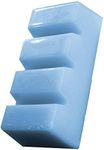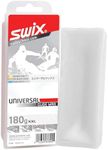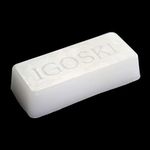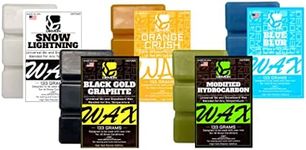Buying Guide for the Best Snowboard Wax
Choosing the right snowboard wax is essential for maintaining your snowboard's performance and ensuring a smooth ride. Waxing your snowboard reduces friction between the board and the snow, allowing for better glide and control. When selecting a snowboard wax, it's important to consider the type of snow conditions you'll be riding in, the temperature, and your personal riding style. Here are some key specifications to help you make an informed decision.Temperature RangeThe temperature range of a snowboard wax indicates the optimal snow temperature for which the wax is designed. This is important because different waxes perform better in different temperature conditions. Waxes are typically categorized into cold, all-temperature, and warm. Cold waxes are best for temperatures below 20°F (-7°C), all-temperature waxes work well in a wide range of conditions, and warm waxes are ideal for temperatures above 25°F (-4°C). To pick the right one for you, consider the typical weather conditions of the area where you usually snowboard. If you ride in varying conditions, an all-temperature wax might be the best choice.
Wax TypeThere are two main types of snowboard wax: rub-on and hot wax. Rub-on wax is easy to apply and convenient for quick touch-ups, making it suitable for casual riders or those who need a quick fix on the slopes. Hot wax, on the other hand, requires an iron for application and provides a more durable and longer-lasting finish. This type is preferred by more serious riders who want the best performance and are willing to invest the time in proper waxing. Choose rub-on wax for convenience and hot wax for performance and longevity.
Fluorocarbon ContentFluorocarbon content in snowboard wax affects its water-repellent properties and overall performance. High-fluorocarbon waxes offer superior glide and are highly water-repellent, making them ideal for competitive riders or those looking for top performance. Low-fluorocarbon or fluorocarbon-free waxes are more environmentally friendly and suitable for recreational riders. If you're an eco-conscious rider or don't need the highest level of performance, opt for low-fluorocarbon or fluorocarbon-free waxes. For competitive or high-performance needs, high-fluorocarbon waxes are the way to go.
Application MethodThe application method of snowboard wax can vary, with some waxes requiring a hot iron for melting and others being rub-on or spray-on. Hot waxing involves melting the wax onto the board with an iron, which provides a thorough and long-lasting coat. Rub-on and spray-on waxes are quicker and easier to apply but may not last as long. If you prefer a quick and easy application, go for rub-on or spray-on waxes. If you want a more durable and effective waxing, invest the time in hot waxing.
DurabilityDurability refers to how long the wax will last on your snowboard before needing reapplication. This is important because a more durable wax means less frequent waxing and better performance over time. Hot waxes generally offer greater durability compared to rub-on waxes. If you ride frequently or in challenging conditions, a more durable wax will save you time and effort in the long run. For occasional riders, a less durable wax might be sufficient.





















